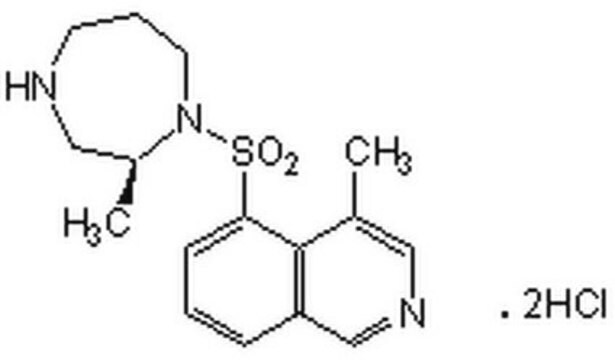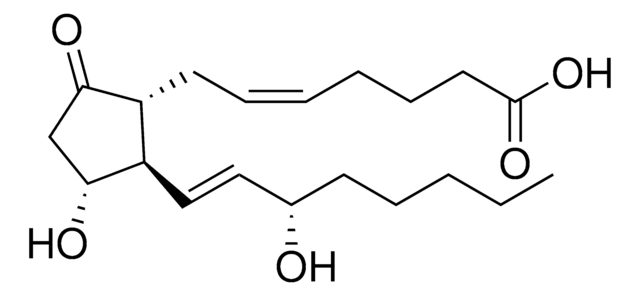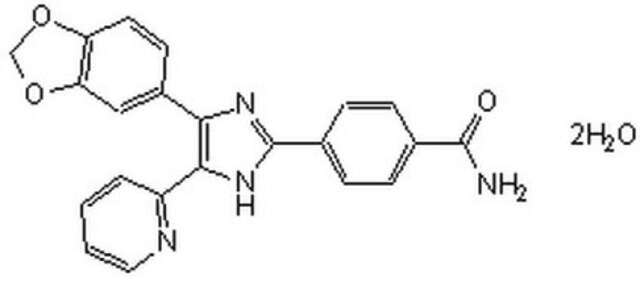688001
Y-27632
InSolution, ≥95%, reversible, inhibitor of Rho kinases
Synonym(s):
InSolution Y-27632, Rho Kinase Inhibitor VI
Sign Into View Organizational & Contract Pricing
All Photos(1)
About This Item
Empirical Formula (Hill Notation):
C14H21N3O · 2HCl · xH2O
Molecular Weight:
320.26 (anhydrous basis)
UNSPSC Code:
12352200
Recommended Products
Quality Level
Assay
≥95% (HPLC)
form
liquid
manufacturer/tradename
Calbiochem®
storage condition
OK to freeze
protect from light
shipped in
wet ice
storage temp.
−20°C
General description
A 5 mM (500 µg/296 µl) aqueous solution of Y-27632 (Cat. No. 688000). A highly potent, cell-permeable, selective inhibitor of Rho-associated protein kinase (Ki = 140 nM for p160ROCK (ROCK-I). Also inhibits ROCK-II with almost equal potency. Inhibition is achieved by competing with ATP for binding to the catalytic site. Exhibits 10- to 50-fold lower affinity for PKCε than p160ROCK. Does not affect the activity of p21-activated protein kinase (PAK) even at high concentrations (~100 mM). Also acts as a potent inhibitor of agonist-induced Ca2+ sensitization of myosin phosphorylation and smooth muscle contractions (IC50 = 700 nM for phenylephrine-induced contractions in aortic strips).
A highly potent, cell-permeable, selective inhibitor of Rho-associated protein kinase (Ki = 140 nM for p160ROCK (ROCK-I). Also inhibits ROCK-II with almost equal potency. Inhibition is achieved by competing with ATP for binding to the catalytic site. Exhibits 10- to 50-fold lower affinity for PKCε than p160ROCK. Does not affect the activity of p21-activated protein kinase (PAK) even at high concentrations (~100 mM). Also acts as a potent inhibitor of agonist-induced Ca2+ sensitization of myosin phosphorylation and smooth muscle contractions (IC50 = 700 nM for phenylephrine-induced contractions in aortic strips).
Biochem/physiol Actions
Cell permeable: yes
Primary Target
p160ROCK
p160ROCK
Product competes with ATP.
Reversible: no
Target IC50: 700 nM against phenylephrine-induced contractions in aortic strips
Target Ki: 140 nM for p160ROCK (ROCK-I)
Packaging
Packaged under inert gas
Warning
Toxicity: Harmful (C)
Physical form
A 5 mM (500 µg/296 µl) solution of Y-27632 (Cat. No. 688000) in H₂O.
Reconstitution
Following initial thaw, aliquot and freeze (-20°C).
Other Notes
Chitaley, K., et al. 2001. Nat. Med.7, 119.
Davies, S.P., et al. 2000. Biochem. J. 351, 95.
Narumiya, S., et al. 2000. Methods Enzymol.325, 273.
Hirose, M., et al. 1999. J. Cell Biol.141, 1625.
Maekawa, M., et al. 1999. Science285, 895.
Uehata, M., et al. 1997. Nature389, 990.
Davies, S.P., et al. 2000. Biochem. J. 351, 95.
Narumiya, S., et al. 2000. Methods Enzymol.325, 273.
Hirose, M., et al. 1999. J. Cell Biol.141, 1625.
Maekawa, M., et al. 1999. Science285, 895.
Uehata, M., et al. 1997. Nature389, 990.
Legal Information
Sold under license of PCT Application W098/06,433A1 and under license from Mitsubishi Pharma Tanabe Corporation.
CALBIOCHEM is a registered trademark of Merck KGaA, Darmstadt, Germany
Storage Class Code
12 - Non Combustible Liquids
WGK
WGK 2
Flash Point(F)
Not applicable
Flash Point(C)
Not applicable
Certificates of Analysis (COA)
Search for Certificates of Analysis (COA) by entering the products Lot/Batch Number. Lot and Batch Numbers can be found on a product’s label following the words ‘Lot’ or ‘Batch’.
Already Own This Product?
Find documentation for the products that you have recently purchased in the Document Library.
Customers Also Viewed
Sylvia J Gasparini et al.
The Journal of clinical investigation, 132(12) (2022-04-29)
Once human photoreceptors die, they do not regenerate, thus, photoreceptor transplantation has emerged as a potential treatment approach for blinding diseases. Improvements in transplant organization, donor cell maturation, and synaptic connectivity to the host will be critical in advancing this
Aaron C Brown et al.
Methods in molecular biology (Clifton, N.J.), 1926, 63-75 (2019-02-12)
Nephrons differentiate from the cap mesenchyme of the fetal kidney. Nephron progenitor cells that populate the cap mesenchyme efficiently balance self-renewal and epithelial differentiation to enable repeated rounds of nephron formation during development. Here we describe a method to isolate
Rosita Bergström et al.
Methods in molecular biology (Clifton, N.J.), 767, 125-136 (2011-08-09)
Stem cell culture systems that rely on undefined animal-derived components introduce variability to the cultures and complicate their therapeutic use. The derivation of human embryonic stem cells and the development of methods to produce induced pluripotent stem cells combined with
Cory J Smith et al.
Nucleic acids research, 48(9), 5183-5195 (2020-04-22)
To extend the frontier of genome editing and enable editing of repetitive elements of mammalian genomes, we made use of a set of dead-Cas9 base editor (dBE) variants that allow editing at tens of thousands of loci per cell by
Hyunjae Chung et al.
STAR protocols, 3(3), 101617-101617 (2022-08-23)
Induced pluripotent stem cell (iPSC)-derived kidney organoids can be used for disease modeling and drug testing. Here, we describe a protocol to prepare stocks of an infectious clone of SARS-CoV-2 expressing a stable mNeonGreen reporter (icSARS-CoV-2-mNG). We demonstrate the infection
Our team of scientists has experience in all areas of research including Life Science, Material Science, Chemical Synthesis, Chromatography, Analytical and many others.
Contact Technical Service







